Swedish America and Africa: Stockholm's colonial expansion
The growth of the colonial appetites of the Swedish crown was associated with a significant political strengthening of Sweden in the middle of the XVII century, associated with the ascension to the throne of King Charles X August. It was during his reign that Sweden managed, according to the World of Roskill, to obtain a number of lands from Denmark (Trondheim, Bornholm, Blekinge, Skåne, Halland and Bohuslän). True, Trondheim and Bornholm soon had to be returned back to the Danish kingdom, but Sweden got hold of the whole of Livland. In the period described, the power of the Swedish crown extended to the entire territory of modern Sweden and Finland, and also to Estland, Livonia, Ingermanland, Eastern Pomerania and the German Werden, Wismar and Bremen. Naturally, the strengthening of the military-political power of the Swedish crown in Europe was accompanied by the emergence of ambitious plans to extend the influence of Stockholm on the overseas territories.
Swedish Gold Coast
One of the most "tidbits" for European states in the XVII century was considered the coastal areas of West Africa. They were called “shores” - Ivory Coast, Slave Coast, Gold Coast. The Portuguese, French, British, Dutch and even Danes managed to acquire their trading stations here. The Swedes were no exception.
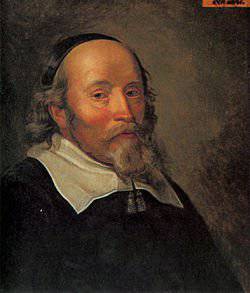 Even when he was head of the Swedish state of Queen Christina, 15 in December 1649, the sixty-two-year-old businessman Louis de Geer, a Dutchman, received permission from Stockholm for exclusive trade on behalf of Sweden with all African, Asian and American territories. This is how the Swedish African Company appeared, whose manager Henrik Karloff landed on the West African coast in 1650 on the territory of the so-called Gold Coast (now Ghana). Like other European businessmen - colonizers, he began to lay the trading post.
Even when he was head of the Swedish state of Queen Christina, 15 in December 1649, the sixty-two-year-old businessman Louis de Geer, a Dutchman, received permission from Stockholm for exclusive trade on behalf of Sweden with all African, Asian and American territories. This is how the Swedish African Company appeared, whose manager Henrik Karloff landed on the West African coast in 1650 on the territory of the so-called Gold Coast (now Ghana). Like other European businessmen - colonizers, he began to lay the trading post. In April, 1650, Karloff, purchased from a local leader of one of the Ashanti tribes (Ashanti - one of the greatest peoples of Ghana) a piece of land in the Cape Corso region. In the acquired territory was erected fort Karlsborg. A little later, the Swedes built a few more possessions. Among them is Fort William (Annamabo), who was under Swedish control in 1650-1657; Fort Buttenstein, ruled by the Swedes from 1650 to 1656; Fort Christianborg, ruled by the Swedes in 1652-1658; Fort Witzen (Takorari), ruled by the Swedes in 1653-1658; Fort Apollonia (Swedish from 1655 to 1657), as well as trading stations Hemorrhea and Akkara.
However, the remoteness of Sweden, together with its economic weakness compared with England and Holland, did not at all contribute to the development of maritime trade with the West African coast. First of all, the Swedes faced desperate resistance from competitors. Thus, the British seized seven ships of the Swedish African Company, referring to the ownership of the Gold Coast of England and to participating in the affairs of the Swedish African Company of Dutch citizens (at that time England was at war with Holland, competing for influence on the sea routes). Although in 1653, ships and cargo were nevertheless returned to the Swedish African Company, the latter suffered serious losses. This affected the overall state of the colonial policy of Sweden.
Meanwhile, in 1656, Henrik Karloff was removed from his post as the manager of a Swedish African company. Naturally, the “promising manager” was unhappy with this turn of events and, without thinking twice, went over to the side of Denmark, which was competing with Sweden. The Danish government was also very interested in the West African coast. In December 1657, Karloff traveled to West Africa on the Danish eighteen-cannon ship "Glukstadt" and landed on the territory of the Swedish colony in Gemorrhea in January 1658. January 27 Karloff detachment was captured fort Karlsborg. The Swedish garrison, in which there were only 16 soldiers, could not resist and the fort passed into the hands of the Danes. The new director of the Swedish African company Johan Philip von Krusenstern who was in Karlsborg was captured. In addition to Karlsborg, the Danes captured other Swedish trading posts on the Gold Coast - Gemorrhea, Annamabo, Akkar and Takkorri.
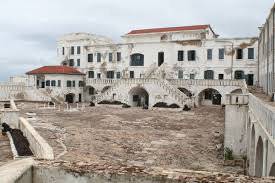 After Denmark captured the Swedish trading post, Karloff returned to Denmark in June 1658. Despite a note of protest from the Swedish government, the Danish crown refused to compensate for the damage incurred as a result of Karloff’s actions, and in August 1658, another Danish-Swedish war began. According to the peace treaty concluded between Sweden and Denmark in Copenhagen in May 1660, Swedish sovereignty was restored over the factories seized by Karloff, but Denmark did not pay for the material damage incurred. But, as it turned out, back in March 1659, delivered by Karloff at the head of Karlsborg and the surrounding factories, his assistant Samuel Schmidt sold the Swedish Gold Coast of the Dutch West Indies Company and with the amount received he fled to Angola. However, Karlsborg and trading posts seized the local tribes almost immediately after this transaction. In December 1659, the leader of the euthut tribe turned to Sweden with a proposal to regain its dominance on the Gold Coast.
After Denmark captured the Swedish trading post, Karloff returned to Denmark in June 1658. Despite a note of protest from the Swedish government, the Danish crown refused to compensate for the damage incurred as a result of Karloff’s actions, and in August 1658, another Danish-Swedish war began. According to the peace treaty concluded between Sweden and Denmark in Copenhagen in May 1660, Swedish sovereignty was restored over the factories seized by Karloff, but Denmark did not pay for the material damage incurred. But, as it turned out, back in March 1659, delivered by Karloff at the head of Karlsborg and the surrounding factories, his assistant Samuel Schmidt sold the Swedish Gold Coast of the Dutch West Indies Company and with the amount received he fled to Angola. However, Karlsborg and trading posts seized the local tribes almost immediately after this transaction. In December 1659, the leader of the euthut tribe turned to Sweden with a proposal to regain its dominance on the Gold Coast. Sweden, the proposal of the Africans accepted and in December 1660, a detachment of Swedes arrived from the metropolis and restored the power of Stockholm over Karlsborg. But, a year later, 31 March, March 1662, Karlsborg laid siege to the Danish troops, led by Anton Voss. A long siege of Fort Karlsborg began, lasting more than a year. The Swedish fortress on the Gold Coast fell only 22 on April 1663 of the year. In turn, in 1664, the fort and trading posts were captured by the British. Thus ended the colonial presence of Sweden on the West African coast, which lasted for almost one and a half decades (intermittently). Since then, several centuries have passed and the memory of the Swedish colonial epic on the territory of modern Ghana has practically not been preserved. Moreover, it was “shaded” by a longer Danish presence - after all, the Swedish forts became the property of the Danes.
New Sweden
A much longer and more noticeable was the colonial expansion of the Swedes on the American continent. Already in the first half of the 1637th century, Sweden, gaining military-political and economic power, turned to the colonization of North American lands, which at that time were not yet completely demarcated between the major European powers. In XNUMX, a new Swedish company was created to trade with North America. Then the expedition of the company undertook its first voyage to North America - on the ships Squid Nyukkel and Vogel Grip. Flotilla commanded by Admiral Klas Fleming, and the general leadership of the expedition was carried out by Peter Minuit (1589-1638) - a Walloon by nationality, who at one time led the Dutch colony in North America “New Netherlands”.
29 March 1638, the Swedes landed at the mouth of the Delaware River. Here was laid the fort of Christina, which was to become the administrative and military center of the Swedish colony created.
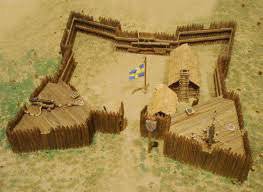 It is easy to guess, so named the fort in honor of the ruling Swedish Queen Christina. So there was a colony, called "New Sweden". Peter Minuit became its governor, but in the same year he left the colony and died on the way to Europe, on the island of St. Kitts. Mons Nilsson Kling replaced him as governor.
It is easy to guess, so named the fort in honor of the ruling Swedish Queen Christina. So there was a colony, called "New Sweden". Peter Minuit became its governor, but in the same year he left the colony and died on the way to Europe, on the island of St. Kitts. Mons Nilsson Kling replaced him as governor. The Delaware River divided the Dutch (east of the river) and Swedish (west of the river) possessions. Over time, the structure of the colony included ten forts. They lived, served, and engaged in farming about 600 people - Swedish, Finnish, Dutch and German settlers. However, the forest Finns who emigrated from Sweden began to make up the bulk of the population of the colony after a while. They came from the Baltic lands conquered by the Swedish crown. This was explained by the fact that living conditions in the colony for the majority of the Swedes proper seemed very difficult, and the way to North America was long and very risky. But the landless "forest Finns", by and large, had nothing to lose. So they went in search of a better life to distant lands.
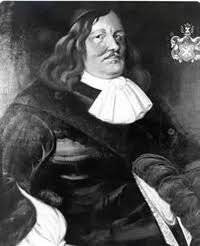 The life of “New Sweden” has never been bright and prosperous, the most stable period of its existence fell on the governorship of Johan Prinz, which lasted from 1643 to 1653. At the time of his appointment as Governor Johan Prince (1592-1663) was 51 year. Coming from a pastor’s family, in his youth he was called Johan Björnsson. It is quite possible that he became a historical figure thanks to a tragic accident. In his youth, Johan studied theology, studied at the University of Rostock, then at the University of Greifswald. Perhaps he would have become a pastor or a teacher, but during his wanderings in the Swabian lands he was captured by soldiers' recruiters. Johan was in Italy, then entered the service in the Austrian army, where he rose to fenrich (ensign). Thus began the adventurous life of a professional military mercenary. After the defeat of the Braunschweig regiment of the Austrian army, Johan, by then a former lieutenant, went to the Danish colonel Rantzau and served in France for a year and a half. In 1625, Johan returned to his homeland, where, with the rank of lieutenant, he began serving in the Swedish army. Participated in the Thirty Years War in Germany, reached the rank of lieutenant colonel. He was arrested by the Swedish government for surrendering the town of Chemnitz to the enemy and, despite being released from prison, was dismissed from military service. After his dismissal, Johan began recruiting colonists to New Sweden and in August 1642 was appointed governor of the colony. Although Johan Prince arrived in New Sweden itself only a year later - in October 1643.
The life of “New Sweden” has never been bright and prosperous, the most stable period of its existence fell on the governorship of Johan Prinz, which lasted from 1643 to 1653. At the time of his appointment as Governor Johan Prince (1592-1663) was 51 year. Coming from a pastor’s family, in his youth he was called Johan Björnsson. It is quite possible that he became a historical figure thanks to a tragic accident. In his youth, Johan studied theology, studied at the University of Rostock, then at the University of Greifswald. Perhaps he would have become a pastor or a teacher, but during his wanderings in the Swabian lands he was captured by soldiers' recruiters. Johan was in Italy, then entered the service in the Austrian army, where he rose to fenrich (ensign). Thus began the adventurous life of a professional military mercenary. After the defeat of the Braunschweig regiment of the Austrian army, Johan, by then a former lieutenant, went to the Danish colonel Rantzau and served in France for a year and a half. In 1625, Johan returned to his homeland, where, with the rank of lieutenant, he began serving in the Swedish army. Participated in the Thirty Years War in Germany, reached the rank of lieutenant colonel. He was arrested by the Swedish government for surrendering the town of Chemnitz to the enemy and, despite being released from prison, was dismissed from military service. After his dismissal, Johan began recruiting colonists to New Sweden and in August 1642 was appointed governor of the colony. Although Johan Prince arrived in New Sweden itself only a year later - in October 1643. Johan Prince laid new forts on the territory of the colony. At this time in New Sweden began the cultivation of tobacco, which has become the main export crop. Nevertheless, the number of emigrants arriving from Sweden has always remained extremely small compared with the colonies of other European countries, especially with British possessions. In the end, it was precisely the small size of the population and the economic weakness of Sweden that became the two most important factors that did not allow the colony to expand and eventually led to its dissolution in the neighboring possessions of other European countries.
Despite the fact that at first there was no serious conflict with neighboring colonies of other states, friction between New Sweden and the British and Dutch possessions did occur. Back in 1644, New Sweden took the side of the Sasquekhannock Indian tribe in its opposition to the English possession of Maryland. The Dutch, who settled on the east bank of the Delaware River, in the New Netherlands colony did not initially quarrel with New Sweden. The situation changed in 1651. A Dutch fort, Casimir, was built at the mouth of the Delaware River, which caused a sharply negative reaction from the Swedes. Swedish governor Johan Rising, at the head of a detachment of soldiers and settlers, occupied the fort without encountering resistance from the Dutch.
However, in September 1655, the Dutch came to their senses. An expedition of 317 soldiers and officers on 7 ships was sent to New Sweden. The Dutch squad not only returned the Casimir fort to New Netherland, but also forced the Swedish governor, Johan Rising, to surrender. Rising surrendered the fort after four Dutch artillery batteries were concentrated for its shelling. Since then, the colony of New Sweden has come under the control of the Netherlands. She remained a Dutch possession in 1655-1664, until the New Netherlands was captured by England. However, both under the Dutch and, at first, under the British, the colony maintained wide autonomy. At that time there were few white settlers in North America, and for the Dutch and, then, the English authorities did not play a large role in the nationality of the colonists. Therefore, the Swedes and Finns were allowed to have their own self-government bodies and even their own militia. Only in 1681, the autonomy of New Sweden was finally eliminated and it became part of Pennsylvania.
A small part of the colonists - the Swedes and the Finns - after the transition of New Sweden under the Dutch administration did not want to stay in North America and returned to Europe. Among them was the former governor Johan Rising, who no longer held official posts and died in poverty in Stockholm. Most of the colonists remained in the new place of residence and gradually assimilated into the surrounding Dutch and English population. However, in the XIX - XX centuries. The massive migration of Swedes to the United States of America has begun, and at least about four million people of Swedish origin live in the United States.
St. Barthelemy: Swedish Harbor
But the longest in time and noticeable cultural influence and trace in history was the presence of the Swedes in the West Indies. As early as the middle of the 18th century, Swedish merchants, and then the Government of Sweden, became interested in the development of trade in the Caribbean. However, attempts to establish direct trade with the West Indies, bypassing the Spanish, Dutch and other intermediaries, met with a sharp rejection from the governments of European countries that had colonies in the Caribbean. The situation changed in 1784, when Sweden acquired its own colony in the West Indies. Unlike other colonial possessions, the island of Saint Barthelemy was not conquered or originally colonized by the Swedes. The Swedish government purchased it from France - specifically with the aim of developing maritime trade with the countries of the Caribbean.
Saint Barthelemy was discovered in 1493 by Christopher Columbus himself and got its name in honor of the navigator brother Bartolomeo Columbus. However, the Spaniards treated the development of the island rather superficially and in 1648, French colonists began to settle here. In 1653-1665 The island belonged to the Order of Malta, which bought it from France, but then again came under French control. In 1763, French filibusters settled on the island. In carrying out attacks on foreign merchant ships, primarily Spanish, filibusters hid their wealth on the island and rested in the intervals between sea raids. The island was the headquarters of the pirate captain Daniel Monbara. Many aging pirates who survived the battles and avoided a premature death in fights or death from alcohol settled down and invested funds looted in their youth in the creation of trading shops, taverns and farms. This was the settlement of the island and its economic infrastructure was developing. The specificity of the island was that it did not develop plantation cultivation of sugar cane - the small size of the island, as well as soil features and the absence of significant water sources, had an effect. Perhaps it was these factors that prompted the sale of Sweden's Saint Barthelemy on 1784. The island’s administrative center was renamed Gustavia, in honor of the Swedish king Gustav III. It was assumed that St. Barthelemy would become the main transshipment point for Swedish exports to North America and West Indian goods to Sweden. With regard to participation in the slave trade, the Swedes during the reign of the island almost did not import African slaves, preferring a limited purchase of slaves in neighboring Guadeloupe.
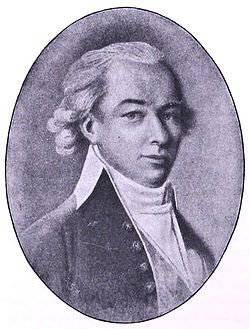 The first governor of Saint-Barthelemy was Salomon Mauritz von Ryallin (1757-1825). In 1773, he began service with the fenrich (midshipman) of the navy, in 1780-1782. served in the French Navy, then returned to the Swedish service. In 1785-1787 he served as governor of St. Barthelemy, then was recalled to the metropolis, where he held important government posts and in 1791 he was promoted to rear admiral, and in 1799 he was admiral of the Swedish fleet.
The first governor of Saint-Barthelemy was Salomon Mauritz von Ryallin (1757-1825). In 1773, he began service with the fenrich (midshipman) of the navy, in 1780-1782. served in the French Navy, then returned to the Swedish service. In 1785-1787 he served as governor of St. Barthelemy, then was recalled to the metropolis, where he held important government posts and in 1791 he was promoted to rear admiral, and in 1799 he was admiral of the Swedish fleet. The Swedish West Indies Company was established to trade with St. Barthelemy 31 in October 1786 of the year. The government of Sweden granted it the right of monopoly trade with St. Barthelemy and other islands of the West Indies, while the director of the company was appointed by the king of Sweden. The company's competence included not only trading operations with the West Indies and the sale of goods brought from there, but also many administrative functions. In particular, the company was responsible for collecting taxes and customs duties in the colony of Saint Barthelemy, pledged to repair and maintain the port of Gustavia, pay salaries to officials of the Swedish administration on the island. At the same time, the governor and the military garrison were subordinate to the Swedish government, but were kept at the expense of withdrawing a quarter of the income from the Swedish West India Company. By the way, the garrison of the colony at St. Barthelemy has always been extremely small and weak militarily. So, by 1801, when the island was temporarily captured by the British, the Swedish troops stationed in the capital of the colony Gustavia numbered only 35 soldiers and officers and 18 disabled people who were in garrison service.
However, despite such significant privileges, by the beginning of the XIX century the company ceased to bring a serious income to the Swedish government. Moreover, in 1801-1802. the island was temporarily under the control of the British, who fought with piracy in the Caribbean. However, later England returned him to Sweden. In 1805, the king of Sweden revoked the privileges of the Swedish West India Company. In 1815, all administrative functions previously assigned to the company were transferred to the governor. A significant event for the island was the release of black slaves in 1847. After that, the majority of Negroes migrated to neighboring Guadeloupe (it should be noted that in 1813-1814, Guadeloupe was ruled by Sweden). By the way, the slave trade, the monopoly of which belonged to the Swedish West India Company, was carried out mainly as a transit point. From Guinea, slaves were brought to St. Barthelemy and from there they were shipped to Cuba and other Caribbean colonies.
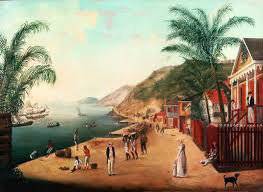 The colony on Saint-Barthelemy experienced a certain economic bloom at the turn of the 18th-19th centuries, which was associated with the consequences of the abolition of slavery in the French colonies after the Great French Revolution and the beginning of mass Negro uprisings. Fleeing from "black racism", many families of white planters, and simply people of European descent, fled to the colonies of Great Britain, the Netherlands, Denmark and Sweden. Some families ended up on St. Barthelemy, making a certain contribution to the development of the island’s economy. In addition, the population of the colony was replenished by emigrants from the metropolis itself. As in the case of New Sweden, a significant part of the settlers coming from the metropolis were Finns - landless and landless Finnish peasants, for whom the West Indies painted almost a paradise on earth, where they can live in warmth and contentment in better conditions than at home. The population of the colony at that time was growing rapidly: if by the time the island was transferred to Sweden in 1784, it was completely uninhabitable, then two years later 348 Swedes lived there, and in 1800, after 16 years, the population of Gustavia, the island’s capital, amounted to 5 thousand people. Thus, the city turned into a quite large shopping and administrative center by Caribbean standards. The population of Gustavia was multinational and socially polarized. In the city to the beginning of the XIX century. 5 schools operated, practiced six doctors, there were a sufficient number of shops, hotels and pubs.
The colony on Saint-Barthelemy experienced a certain economic bloom at the turn of the 18th-19th centuries, which was associated with the consequences of the abolition of slavery in the French colonies after the Great French Revolution and the beginning of mass Negro uprisings. Fleeing from "black racism", many families of white planters, and simply people of European descent, fled to the colonies of Great Britain, the Netherlands, Denmark and Sweden. Some families ended up on St. Barthelemy, making a certain contribution to the development of the island’s economy. In addition, the population of the colony was replenished by emigrants from the metropolis itself. As in the case of New Sweden, a significant part of the settlers coming from the metropolis were Finns - landless and landless Finnish peasants, for whom the West Indies painted almost a paradise on earth, where they can live in warmth and contentment in better conditions than at home. The population of the colony at that time was growing rapidly: if by the time the island was transferred to Sweden in 1784, it was completely uninhabitable, then two years later 348 Swedes lived there, and in 1800, after 16 years, the population of Gustavia, the island’s capital, amounted to 5 thousand people. Thus, the city turned into a quite large shopping and administrative center by Caribbean standards. The population of Gustavia was multinational and socially polarized. In the city to the beginning of the XIX century. 5 schools operated, practiced six doctors, there were a sufficient number of shops, hotels and pubs. The weakening of interstate rivalry in the Caribbean, due to which Saint-Barthélemy owned by neutral Sweden acted as a trading center, led to a deterioration of the economic situation on the island. As its content became increasingly expendable, the Swedish government decided to sell the island of France. In accordance with the Paris Treaty of 10 in August 1877, the island became part of France, which included it in its colony of Guadeloupe. For the island of Swedish King Oscar II received an amount of 320 thousand francs. At the same time, the transition of the island under French jurisdiction was made quite democratic. A referendum was held, in which only one of the adult residents of the island who took part in it, voted against joining France. So Sweden lost its last overseas colonial possession.
Asian fiasco
Our story about the overseas colonies of Sweden would be incomplete if we did not recall the attempts of Sweden to gain a foothold in South Asia. True, these attempts were unsuccessful even more than the colonial expansion in Africa or North America. As you know, India was also a very interesting territory for European powers and trading companies. Virtually every developed European country in the XVII-XIX centuries. possessed its own East India Company. Sweden was no exception. The emergence of the Swedish East India Company was a direct result of the collapse of the Austrian East India Company in 1731. Entrepreneurs who expected to make a profit from their activities in India, hiding behind the Austrian flag, began to look for a new "roof", because to act without a cover of any state meant to deserve accusations of smuggling and appropriate punishment. As a result of the search, Scottish entrepreneur Colin Campbell and German from Gothenburg Niklas Salgren agreed with Henrik Koenig, a Swedish official who managed to bargain for them the right to trade in South Asia.
14 June 1731 The king of Sweden gave Henrik Koenig the right to trade in the East Indies and nearby regions.
However, the development of trade in Sweden with the East Indies immediately caused a negative reaction from other European countries. The first ship, which the Swedes had equipped and sent from Gothenburg, was captured by the Dutch (although it was soon given away). In September, 1733, a detachment of the Swedish East India Company, founded a Swedish trading post in Porto-Novo on the Coromandel coast in South India. But less than a month passed, as in October 1733, the joint Anglo-French troops, sent from the English colony Madras and the French colony Pondicherry, attacked the trading post. All the people in the colony were arrested, and their goods were subject to confiscation. Thus, the Swedish presence on the Coromandel coast did not last more than a month. Seeing what expects the colonies created in India, the Swedish East India Company decided not to enter into confrontation with a stronger adversary and abandoned the Indian trade, switching to cooperation with China.
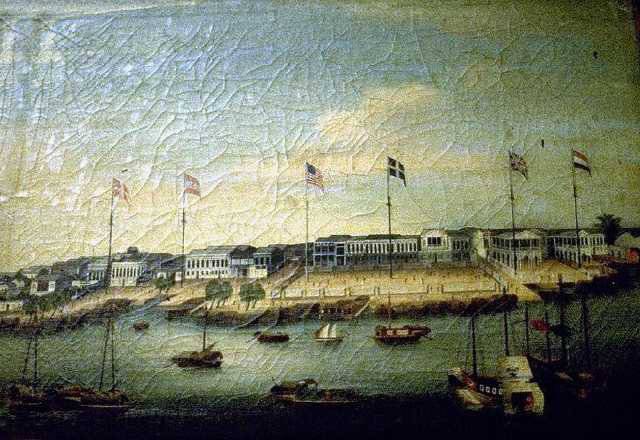
The Swedish flag, among other flags of the powers in the trading station in the territory of the Chinese Canton
The last idea was much more successful. During the first franchise, the company carried out 22 expeditions to China and 3 to Bengal. During the second privilege, issued for the next twenty years, 14 expeditions to China were sent, then, after the company was reorganized, the 21 expedition to China and the 1 expedition to India. The third privilege was marked by 39 naval expeditions. The further development of transoceanic trade with China was hindered by the Napoleonic wars, which created an obstacle for the owners of the company and during the fourth privilege they could not collect a single flight.
Thus, it can be concluded that the development of Sweden’s colonial expansion into overseas lands was impeded by several factors at once. Firstly, the level of economic development of Sweden is insufficient compared with other European countries. The Swedish monarchy missed the era of great geographical discoveries, when the colonial expansion of Spain and Portugal began, but could not, due to economic weakness, adequately act as a competitor to the new colonial powers - England and Holland - in the XVII-XVIII centuries.
Secondly, the abstractness of Sweden with European problems played a role. The constant struggle for hegemony in the Baltic region, conflicts with Denmark, the Russian empire, also delayed the forces of the Swedish crown and did not allow it to pay considerable attention to its overseas projects. Finally, Sweden has always been very sparsely populated and, accordingly, could not provide the colonies with the number of settlers necessary at least to maintain Swedish sovereignty on the territory of trading posts. So, in New Sweden, only 600 people lived, which was ten times smaller than the population of the English and even Dutch colonies in the same region of North America. From 1814, Sweden switched to a policy of neutrality, which did not allow it to conflict with other European states in the struggle for colonial possessions.
Information